#live Sustainable
Text
It’s an open secret in fashion. Unsold inventory goes to the incinerator; excess handbags are slashed so they can’t be resold; perfectly usable products are sent to the landfill to avoid discounts and flash sales. The European Union wants to put an end to these unsustainable practices. On Monday, [December 4, 2023], it banned the destruction of unsold textiles and footwear.
“It is time to end the model of ‘take, make, dispose’ that is so harmful to our planet, our health and our economy,” MEP Alessandra Moretti said in a statement. “Banning the destruction of unsold textiles and footwear will contribute to a shift in the way fast fashion manufacturers produce their goods.”
This comes as part of a broader push to tighten sustainable fashion legislation, with new policies around ecodesign, greenwashing and textile waste phasing in over the next few years. The ban on destroying unsold goods will be among the longer lead times: large businesses have two years to comply, and SMEs have been granted up to six years. It’s not yet clear on whether the ban applies to companies headquartered in the EU, or any that operate there, as well as how this ban might impact regions outside of Europe.
For many, this is a welcome decision that indirectly tackles the controversial topics of overproduction and degrowth. Policymakers may not be directly telling brands to produce less, or placing limits on how many units they can make each year, but they are penalising those overproducing, which is a step in the right direction, says Eco-Age sustainability consultant Philippa Grogan. “This has been a dirty secret of the fashion industry for so long. The ban won’t end overproduction on its own, but hopefully it will compel brands to be better organised, more responsible and less greedy.”
Clarifications to come
There are some kinks to iron out, says Scott Lipinski, CEO of Fashion Council Germany and the European Fashion Alliance (EFA). The EFA is calling on the EU to clarify what it means by both “unsold goods” and “destruction”. Unsold goods, to the EFA, mean they are fit for consumption or sale (excluding counterfeits, samples or prototypes)...
The question of what happens to these unsold goods if they are not destroyed is yet to be answered. “Will they be shipped around the world? Will they be reused as deadstock or shredded and downcycled? Will outlet stores have an abundance of stock to sell?” asks Grogan.
Large companies will also have to disclose how many unsold consumer products they discard each year and why, a rule the EU is hoping will curb overproduction and destruction...
Could this shift supply chains?
For Dio Kurazawa, founder of sustainable fashion consultancy The Bear Scouts, this is an opportunity for brands to increase supply chain agility and wean themselves off the wholesale model so many rely on. “This is the time to get behind innovations like pre-order and on-demand manufacturing,” he says. “It’s a chance for brands to play with AI to understand the future of forecasting. Technology can help brands be more intentional with what they make, so they have less unsold goods in the first place.”
Grogan is equally optimistic about what this could mean for sustainable fashion in general. “It’s great to see that this is more ambitious than the EU’s original proposal and that it specifically calls out textiles. It demonstrates a willingness from policymakers to create a more robust system,” she says. “Banning the destruction of unsold goods might make brands rethink their production models and possibly better forecast their collections.”
One of the outstanding questions is over enforcement. Time and again, brands have used the lack of supply chain transparency in fashion as an excuse for bad behaviour. Part of the challenge with the EU’s new ban will be proving that brands are destroying unsold goods, not to mention how they’re doing it and to what extent, says Kurazawa. “Someone obviously knows what is happening and where, but will the EU?”"
-via British Vogue, December 7, 2023
#fashion#slow fashion#style#european union#eu#eu news#eu politics#sustainability#upcycle#reuse#reduce reuse recycle#ecofriendly#fashion brands#fashion trends#waste#sustainable fashion#sustainable living#eco friendly#good news#hope
10K notes
·
View notes
Text
Homemaking, gardening, and self-sufficiency resources that won't radicalize you into a hate group

It seems like self-sufficiency and homemaking skills are blowing up right now. With the COVID-19 pandemic and the current economic crisis, a lot of folks, especially young people, are looking to develop skills that will help them be a little bit less dependent on our consumerist economy. And I think that's generally a good thing. I think more of us should know how to cook a meal from scratch, grow our own vegetables, and mend our own clothes. Those are good skills to have.
Unfortunately, these "self-sufficiency" skills are often used as a recruiting tactic by white supremacists, TERFs, and other hate groups. They become a way to reconnect to or relive the "good old days," a romanticized (false) past before modern society and civil rights. And for a lot of people, these skills are inseparably connected to their politics and may even be used as a tool to indoctrinate new people.
In the spirit of building safe communities, here's a complete list of the safe resources I've found for learning homemaking, gardening, and related skills. Safe for me means queer- and trans-friendly, inclusive of different races and cultures, does not contain Christian preaching, and does not contain white supremacist or TERF dog whistles.
Homemaking/Housekeeping/Caring for your home:
Making It by Kelly Coyne and Erik Knutzen [book] (The big crunchy household DIY book; includes every level of self-sufficiency from making your own toothpaste and laundry soap to setting up raised beds to butchering a chicken. Authors are explicitly left-leaning.)
Safe and Sound: A Renter-Friendly Guide to Home Repair by Mercury Stardust [book] (A guide to simple home repair tasks, written with rentals in mind; very compassionate and accessible language.)
How To Keep House While Drowning by KC Davis [book] (The book about cleaning and housework for people who get overwhelmed by cleaning and housework, based on the premise that messiness is not a moral failing; disability and neurodivergence friendly; genuinely changed how I approach cleaning tasks.)
Gardening
Rebel Gardening by Alessandro Vitale [book] (Really great introduction to urban gardening; explicitly discusses renter-friendly garden designs in small spaces; lots of DIY solutions using recycled materials; note that the author lives in England, so check if plants are invasive in your area before putting them in the ground.)
Country/Rural Living:
Woodsqueer by Gretchen Legler [book] (Memoir of a lesbian who lives and works on a rural farm in Maine with her wife; does a good job of showing what it's like to be queer in a rural space; CW for mentions of domestic violence, infidelity/cheating, and internalized homophobia)
"Debunking the Off-Grid Fantasy" by Maggie Mae Fish [video essay] (Deconstructs the off-grid lifestyle and the myth of self-reliance)
Sewing/Mending:
Annika Victoria [YouTube channel] (No longer active, but their videos are still a great resource for anyone learning to sew; check out the beginner project playlist to start. This is where I learned a lot of what I know about sewing.)
Make, Sew, and Mend by Bernadette Banner [book] (A very thorough written introduction to hand-sewing, written by a clothing historian; lots of fun garment history facts; explicitly inclusive of BIPOC, queer, and trans sewists.)
Sustainability/Land Stewardship
Braiding Sweetgrass by Robin Wall Kimmerer [book] (Most of you have probably already read this one or had it recommended to you, but it really is that good; excellent example of how traditional animist beliefs -- in this case, indigenous American beliefs -- can exist in healthy symbiosis with science; more philosophy than how-to, but a great foundational resource.)
Wild Witchcraft by Rebecca Beyer [book] (This one is for my fellow witches; one of my favorite witchcraft books, and an excellent example of a place-based practice deeply rooted in the land.)
Avoiding the "Crunchy to Alt Right Pipeline"
Note: the "crunchy to alt-right pipeline" is a term used to describe how white supremacists and other far right groups use "crunchy" spaces (i.e., spaces dedicated to farming, homemaking, alternative medicine, simple living/slow living, etc.) to recruit and indoctrinate people into their movements. Knowing how this recruitment works can help you recognize it when you do encounter it and avoid being influenced by it.
"The Crunchy-to-Alt-Right Pipeline" by Kathleen Belew [magazine article] (Good, short introduction to this issue and its history.)
Sisters in Hate by Seyward Darby (I feel like I need to give a content warning: this book contains explicit descriptions of racism, white supremacy, and Neo Nazis, and it's a very difficult read, but it really is a great, in-depth breakdown of the role women play in the alt-right; also explicitly addresses the crunchy to alt-right pipeline.)
These are just the resources I've personally found helpful, so if anyone else has any they want to add, please, please do!
#homemaking#homemaking resources#gardening#urban gardening#self sufficiency#self sufficient living#sustainability#sustainable living#homesteading#nontrad homemaker#nontrad housewife#urban homesteading#solarpunk#cottagecore#kitchen witch#kitchen witchcraft#crunchy to alt right pipeline#book rec#book recommendations#resource#long post#mine#racism tw#racism mention#transphobia tw#transphobia mention
2K notes
·
View notes
Text
for anyone who doesn't have the Return YouTube Dislike Plugin, here's how Watcher Entertainment's "Goodbye Youtube" video is doing right now
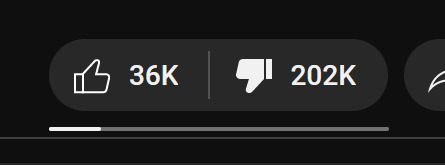
yeah... gonna throw out a yikes on that one
i suspect this number will only keep growing in the coming days/weeks, especially the longer and longer we go without any sort of response.
EDIT: its only been three hours and the number has already jumped to 206K dislikes.
#the fucking balls to link to their merch store on the announcement video too#as a long time fan i'm very disappointed#i get that creatives want to and SHOULD be paid fairly for their work.#hell my dad got laid off by MF DISNEY for wanting to be paid a fair wage for the work he was doing#but we're not talking about the billion dollar mega-corporation Disney here#we're talking about a company that by *all respects* should be able to sustain itself off of Youtube Ads & Patreon & Merch & Live Shows-#WITHOUT blowing 100K on flying 6 people out to haunted houses or paying 20 people to make and produce ONE lets play video#in short: Watcher... get your shit together.#watcher entertainment#we are watcher#watcher#shane medej#ryan bergara#steven lim
1K notes
·
View notes
Text
if you haven’t at least tried sewing or crocheting or knitting your own clothes, you really should. even if it’s just one time and you never do it again, i really think everyone should do it at least once
learning how to crochet was what finally made me grasp the abject horror of the fast fashion industry and realize just how laborious and time consuming it is. i have to take a few days off a week so my back/wrists don’t get sore — and i get to do this as a leisure activity in the comfort of my own home, rather than in a sweatshop. it takes dozens of hours to produce a single item. there is just something about trying it yourself that makes you realize just how little the people making our clothes are being paid for retailers to be able to sell clothes at such obscenely low prices.
i understood in the abstract that people were earning literal slave wages to make my clothes, but that concept wasn’t real to me in a way i could understand until i spent 14 hours making something that i myself wouldn’t have even been willing to pay more than $10-20 for if i saw it in a store.
i have not bought any new clothes since learning how to crochet. every time i see clothes at a store (especially obviously handmade items like crochet), and i look at the price tag i feel genuinely sick to my stomach.
i’m not saying everyone needs to make their own clothes in order to be against fast fashion, but what i am saying is if hearing about the conditions and wages secondhand has not been enough to make you stop buying it, if you find yourself becoming desensitized to the suffering of the people who make your things, you should try making something yourself.
you need to see firsthand how physically and mentally demanding it can be and imagine how much worse it would be if you were forced to sit in a sweatshop for 16 hours a day doing it nonstop, earning pennies an hour to do so. you need to spend weeks laboring over something only for it to turn out looking like shit so you realize just how much wisdom and technical skill goes into these supposedly “unskilled” and undervalued jobs. if the abstract concept isn’t enough to get through to you, then you need to get hands on.
#abolish fast fashion#fast fashion#shein#temu#h&m#sustainability#sustainable fashion#sustainable living#diy fashion#sewing#knitting#crochet#anti consumerism#anti capitalism#working class solidarity#sweatshops#ethical fashion#labor rights
673 notes
·
View notes
Text
LunarPunk 🌙
Lunarpunk is Solarpunk for the night dwellers. Similar philosophy and movement but with a darker, bioluminescent, celestial aesthetic. With a focus on Community, Sustainability, Reducing Light Pollution, growing Native Flora and creating a livable and thriving home for the night dwelling Fauna (nocturnal animals, insects, and people too), and obviously, don't forget the Punk.
Lunarpunk is a very new and slowly growing subgenre and community, please continue to add new ideas, add to the conversation of sustainability, do research in your own area about the local flora and fauna, what you can do to help reduce light pollution, even if it's just coming from your home, how to be more energy efficient, how to reduce waste, save money on electricity, see if you can switch your lights to LEDs, speak with your neighbors about switching as well.
Any little bit counts.
#lunarpunk#sustainability#light pollution#environmentalism#ecopunk#solarpunk#recycling#climate change#climate action#night#environmental#envrionmental activists#punk#moon#lunar#flora and fauna#energy efficiency#ecofriendly#sustainable living#reduce reuse recycle
554 notes
·
View notes
Text
not to start whacking the hornet’s nest but i think the most tragic part of ahsoka and anakin’s story together is that from the very first moment, it’s all based on a lie.
ahsoka meets anakin after aotc - he’s already committed an unjustifiable atrocity. he’s already slaughtered the tusken people, and as far as we know, ahsoka never finds out about that. and you know, that would completely and wildly screw up ahsoka’s perceptions of anakin
and i would go so far as to say it would screw with her image of anakin more than the vader reveal. because the vader reveal is like. oh shit your older brother/ best friend has turned into a monster and has committed genocide and is currently trying to kill you
but the tusken massacre reveal is like. oh shit your older brother who tucks you in bed when you’re sick and who makes you laugh so hard your ribs hurt has, for the entire time he’s loved you and you loved in return, been a murderer, and has actively been hiding a horrible, unjustifiable secret
the vader reveal is tragic because the anakin that ahsoka knows and remembers is, to her knowledge, gone forever. the tusken massacre reveal is tragic because the anakin that ahsoka knows and loves is based on a lie
#anakin skywalker#ahsoka tano#star wars the clone wars#the clone wars#not that the anakin ahsoka adores isn’t there. he is. but he’s also the same man as the desert killer. the same man as the jedi killer#one and the same. he loves her and he’s killed and he’ll love her until he kills her#I JUST THINK it would mess her up more than the vader reveal. i don’t know how she’d cope#how do you cope with the knowledge that (to you) all your good bits are from a killer. how do you reconcile your goodness with his#ahsoka is the best parts of anakin. its what sustains her during the fulcrum years. he lives on in her#how do you cope with that?#yooo if anyone is curious i HAVE posted the fic about this (:
10K notes
·
View notes
Text
hey so friendly reminder

stede gives *full body* kisses
#I love it when actors just go full-body like that#because yes kisses with LOTS OF SPACE in between is a thing that happens!#but they're not the *only* kind#and there is a *very particular message* about a full-body one#especially on screen#and that message is#'somebody said we must live in two separate bodies - but my skin says it misses you -#and my blood remembers when it ran through both our veins -#and every part of me just wants to prove a motherfucker wrong - so let's kiss#and kiss -#until our bodies become one again -#and we can finally take a full deep breath of air#instead of the lonely half-measures that sustained us#for all the years it took to find our other halves again#(...which tbh is kind of a lot for one man's hip-to-hip full-dick action kiss to accomplish but like. I calls it like I sees it)#our flag means death#our flag means death s2 spoilers
904 notes
·
View notes
Text
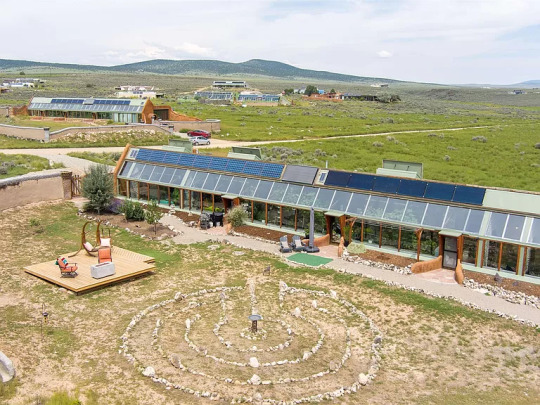

'Vallecitos' is a luxury earthship house built in 2018 in Taos, NM. It's been featured on Netflix, international TV and social media, among the pages of Forbes and AirBnB magazine, and many others, yet it's been on the market for almost 2 yrs. 2bds, 2ba, asking $825K + $20mo. HOA fee. Let's take a look inside.


So, the typically long earthship garden that is usually inside the house, is separate here, and like a greenhouse decorated with bottles in the pretty turquoise walls.

Food grows out here- I see lettuce, aloe vera.

And, look at this- bananas. Or are they plantains?

I must say that the living room is nice, but the dining area is a little tight.
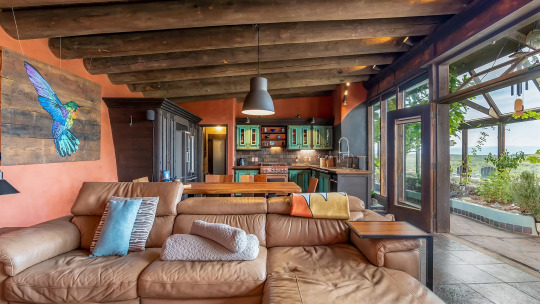
We've seen some pretty primitive earthships before, but this actually looks like a home with beamed ceilings and quality glass doors and windows.

A real kitchen and it's very pretty. Love the turquoise cabinets.
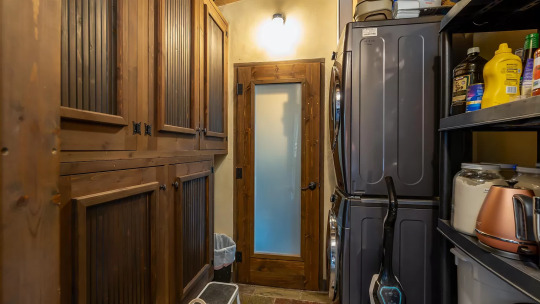
It even has a pantry and laundry room.

Very nice bath and what looks like a real flushing toilet, not a composter.

Beautiful tile sink.


The secondary bedroom is lovely. It looks like a child's room and has plenty storage for toys, games and books. A desk faces the garden window.
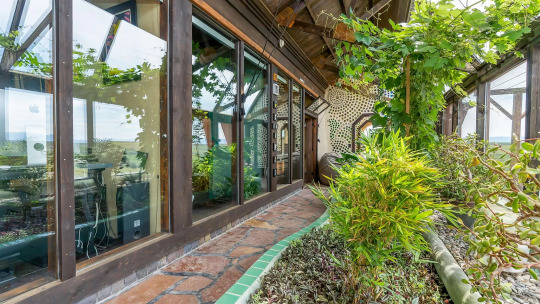
As we can see, the garden runs the whole length of the large "ship."

The primary bedroom is nice.

It opens to the garden area.


Pretty en-suite. I would need something on that window, though.


Out on the patio they have a sauna.

Patio looking out over the 2.31 acre lot.
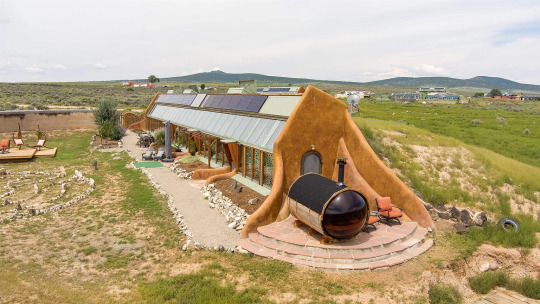
View of the back of th house with the sauna and patio.
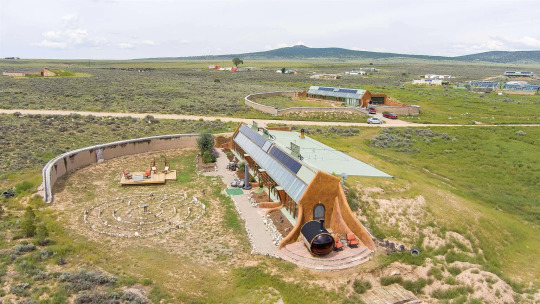

Partial privacy wall around a deck.

Aerial view of the property shows grass and vegetation, but it's quite vast and empty.

Glamor shot of it at night.
https://www.zillow.com/homedetails/27-Earthship-Way-Taos-NM-87577/2061804094_zpid/?
189 notes
·
View notes
Text

from the 'wholistic + abundant {lifestyle}' Pinterest board
#g#infographic#earth stewardship#permaculture#holistic leveling up#leveling up#slow living#soft living#solarpunk#that girl#green juice girl#wellness journey#true being#true nourishment#mindful consumption#ethical consumption#mindfulness#sustainability#eco conscious#ecofeminism#sidewalkchemistry
441 notes
·
View notes
Text

https://thefuturekept.com/products
325 notes
·
View notes
Text
The new 'compost obligatoire' rules came into force on 1 January 2024. Here's what they entail.
As of 1 January 2024, organic waste recycling is mandatory in France under new 'compost obligatoire' rules.
With support from the government’s Green Fund, municipalities must provide residents with ways to sort bio-waste, which includes food scraps, vegetable peels, expired food and garden waste.
Households and businesses are required to dispose of organic matter either in a dedicated small bin for home collection or at a municipal collection point. Previously, only those who generated over five tonnes of organic waste per year were required to separate it.
The waste will then be turned into biogas or compost to replace chemical fertilisers. Alternatively, it can be composted at home.
The obligation is currently on local authorities to provide an easy means for households to compost or separate organic waste.
While facilities are rolled out, there will not be fines imposed for non-compliance. It is yet to be seen whether stricter rules will be imposed in future.
One-third of household waste is bio-waste
Organic waste from food and gardens accounts for almost one-third of household waste. When it is mixed with other rubbish, it typically ends up in landfills or incinerators, where it produces heat-trapping greenhouse gases like methane and CO2.
Food waste is responsible for about 16 per cent of the total emissions from the EU food system, according to the European Commission. Globally, food loss and waste generates around 8 per cent of all human-caused emissions annually, the UN says.
It can also contaminate packaging destined for recycling like paper, plastic and glass.
In 2018, only 34 per cent of the EU’s total bio-waste was collected, leaving 40 million tonnes of potential soil nutrients to be discarded, according to NGO Zero Waste Europe.
In France, an estimated 82 kg of compostable waste per person is thrown away each year.
Is bio-waste separation mandatory in other European countries?
Under the EU’s Waste Framework Directive, bio-waste collection is being encouraged this year, but it stops short of setting mandatory targets.
In many European countries, organic waste separation has already been implemented at the municipal level.
Milan in Italy has been running a residential food waste collection programme since 2014. Households were given dedicated bins and compostable bags to kick off the scheme.
Elsewhere, taxes or bans on incinerating bio-waste have encouraged similar schemes, with separate bins and home composting widespread in Austria, the Netherlands and Belgium.
The UK announced plans to roll out separate food waste collection in 2023. It remains voluntary for households in England, but is more strictly enforced in Wales and for business owners.
How to sort your bio-waste
Ideally, all waste - including organic matter - should be kept to a minimum.
This can be achieved through careful meal planning. Consuming, freezing or preserving food before it expires along with using every part of an ingredient also help to reduce waste. Some food waste can even be repurposed into animal feed.
Any food waste that cannot be saved or repurposed should be either composted or separated for collection. This includes uneaten food scraps, baked goods, dairy products, eggshells, fruit and vegetables and their peels, mouldy food, pet food, raw and cooked meat and fish, bones, tea and coffee grounds.
Liquids, non-food products and packaging should not be placed in bio-waste bins.
-via EuroNews.Green, January 2, 2024
#france#composting#eu#european union#organic waste#biofuels#recycling#sustainability#food#food waste#compost#carbon dioxide#carbon emissions#sustainable living#good news#hope
179 notes
·
View notes
Text
Excuse my poor unsteady hand I'm not used to this type of thing
#doai folie a deux au#doai#alex williams doai#dreams of an insomniac#clyde doai#i have this lil theory in my head that Walex(Winfrey controlling Alex) being outside the asylum is hungry and in Alex's body possibly eats#still living things like animals or even humans to sustain their hunger#and that I've been seeing the doodles of this aus Alex having blood on their mouths and being hungry so i just- ajndnshd#I had the hardest time picking a color pallet for this one
108 notes
·
View notes
Text
thinking about how much more fun stranger things day would be if netflix would agree to sag aftra's reasonable demands for living wages and protections so that the cast could actually be involved and the folks involved could proudly promote their work. instead we have official accounts promoting merch and streaming full episodes on tiktok, because they have nothing better to offer, because they've been dragging their feet on paying the people who actually make their content for literal months.
#stranger things day#stranger things#st cast#sag aftra#sag strike#sag afra strike#obvious disclaimer: folks getting paid living wages and having sustainable careers is more important than me getting new content#so pls do not misconstrue my meaning pls#fuck netflix#fuck the amptp
255 notes
·
View notes
Text
Hot disability tip: For every action that one can do, assume there is at least one person who cannot do that action, both in part or wholly. Then, assume that for every one action, there are at least twenty alternative ways one could achieve it. Will they look different? Yes. Maybe it even makes you uncomfortable, but that doesn't mean that one's discomfort is worth somebody else's life.
#disability#disability advocacy#ableism tw#saw another one of those condescending 'isnt that not sustainable though :(' comments towards. a dosabled person. who CAN'T 'be sustainable'#look i would rather a thousand disabled people live 'unsustainably' than risk their safety or death#a human life is unmeasurably valuable. if disability is what makes you rethink that then i frankly don't want to be near you
208 notes
·
View notes
Photo

What if Volo but wearing that garb from Scarlet & Violet DLC? What then?
#pokemon#pokemon legends arceus#volo#pla volo#ウォロ#mine#fanart#this guy lives rent free in my brain#Immortal Volo just having a nice time at a matsuri!#I just want him back gamefreak cmon give him back to me#give#I can't keep replaying PLA just to hang out with him again it's just not SUSTAINABLE#also tumblr gets this early because I'm impatient#I scheduled this to be posted after a few hours on twitter
929 notes
·
View notes
Text
517 notes
·
View notes